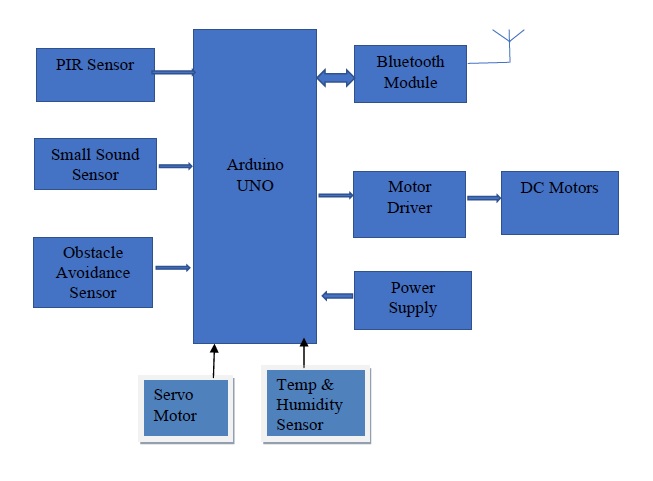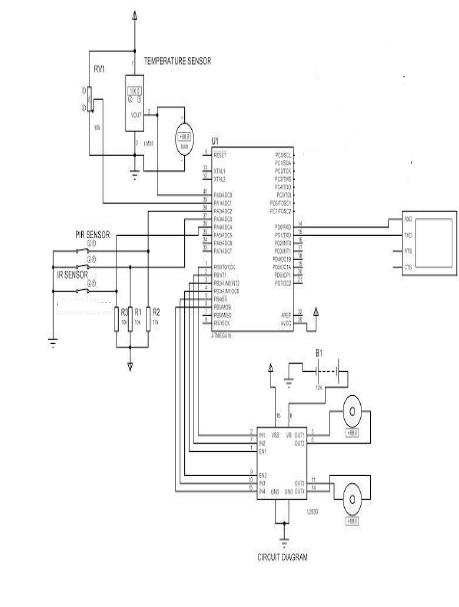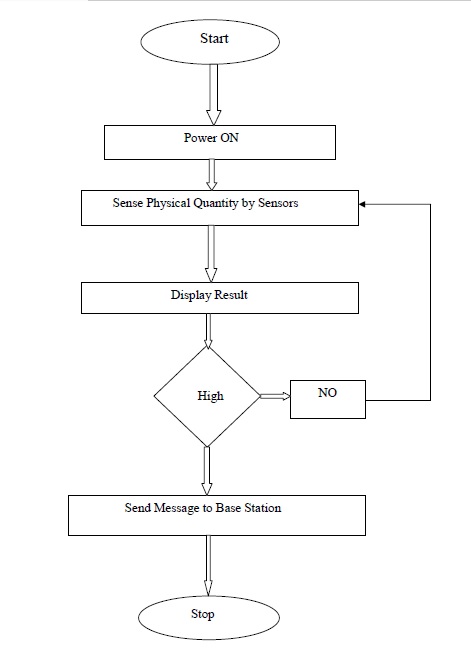#include <NewPing.h> //
#include <AFMotor.h> // You can download the code library below
#include <Servo.h> //
// Ultranic Pin Configuration
#define TRIG_PIN A0
#define ECHO_PIN A1
#define MAX_DISTANCE 400
#define MAX_SPEED 255
#define MAX_SPEED_OFFSET -8
#define COLL_DIST 20
#define TURN_DIST COLL_DIST+10
#define ACT_TIME 250
int calibrationTime = 30;
//the time when the sensor outputs a low impulse
long unsigned int lowIn;
//the amount of milliseconds the sensor has to be low
//before we assume all motion has stopped
long unsigned int pause = 5000;
boolean lockLow = true;
boolean takeLowTime;
int pirPin = A3; //the digital pin connected to the PIR sensor's output
int ledPin = A2;
NewPing sonar(TRIG_PIN, ECHO_PIN, MAX_DISTANCE);
AF_DCMotor motorR(1, MOTOR12_1KHZ); // Set motor #1, 1kHz PWM
AF_DCMotor motorL(4, MOTOR12_1KHZ); // Set motor #2, 1kHz PWM
Servo myservo; // Set servo object to control a servo
String motorSet = "";
int curDist = 0, pos, speedSet = 0;
//int pos;
//int speedSet = 0;
void setup() {
Serial.begin(9600);
pinMode(pirPin, INPUT);
pinMode(ledPin, OUTPUT);
digitalWrite(pirPin, LOW);
//give the sensor some time to calibrate
Serial.print("calibrating sensor ");
for(int i = 0; i < calibrationTime; i++){
Serial.print(".");
delay(1000);
}
Serial.println(" done");
Serial.println("SENSOR ACTIVE");
delay(50);
myservo.attach(9); // Set to attach the servo on pin 9
myservo.write(90); // Write 90 to face servo forward
delay(2000);
motorSet = "FORWARD";
moveForward();
}
void loop() {
checkPath();
if(digitalRead(pirPin) == HIGH){
digitalWrite(ledPin, HIGH); //the led visualizes the sensors output pin state
if(lockLow){
//makes sure we wait for a transition to LOW before any further output is made:
lockLow = false;
Serial.println("---");
Serial.print("motion detected at ");
Serial.print(millis()/1000);
Serial.println(" sec");
delay(50);
}
takeLowTime = true;
}
if(digitalRead(pirPin) == LOW){
digitalWrite(ledPin, LOW); //the led visualizes the sensors output pin state
if(takeLowTime){
lowIn = millis(); //save the time of the transition from high to LOW
takeLowTime = false; //make sure this is only done at the start of a LOW phase
}
//if the sensor is low for more than the given pause,
//we assume that no more motion is going to happen
if(!lockLow && millis() - lowIn > pause){
//makes sure this block of code is only executed again after
//a new motion sequence has been detected
lockLow = true;
Serial.print("motion ended at "); //output
Serial.print((millis() - pause)/1000);
Serial.println(" sec");
delay(50);
}
}
}
void checkPath() {
int curLeft = 0; int curRight = 0; int curFront = 0;
curDist = 0;
checkForward();
myservo.write(135);
delay(100);
for (pos = 135; pos >= 45; pos -= 45) {
myservo.write(pos);
delay(170);
curDist = readPing();
if (curDist < COLL_DIST) { checkCourse(); break; }
if (curDist < TURN_DIST) { changePath(); }
}
}
int readPing() {
int cm = 0;
while (cm < 2) {int uS = sonar.ping(); cm = uS/US_ROUNDTRIP_CM;}
return cm;
}
void checkForward() {
if (motorSet=="FORWARD") { motorR.run(FORWARD); motorL.run(FORWARD); }
}
void changePath() {
if (pos < 90) { veerLeft(); }
if (pos > 90) { veerRight(); }
}
void veerRight() {
motorR.run(BACKWARD); motorL.run(FORWARD);
delay(ACT_TIME);
motorR.run(FORWARD); motorL.run(FORWARD);
motorSet = "FORWARD";
}
void veerLeft() {
motorL.run(BACKWARD); motorR.run(FORWARD);
delay(ACT_TIME);
motorL.run(FORWARD); motorR.run(FORWARD);
motorSet = "FORWARD";
}
void checkCourse() {
moveBackward();
delay(ACT_TIME);
moveStop();
setCourse();
}
void setCourse() {
if (pos < 90) { turnRight(); }
if (pos > 90) { turnLeft(); }
}
void moveBackward() {
motorSet = "BACKWARD";
motorR.run(BACKWARD); // Turn right motor backward
motorL.run(BACKWARD); // Turn left motor backward
for (speedSet = 0; speedSet < MAX_SPEED; speedSet +=2)
{
motorL.setSpeed(speedSet);
motorR.setSpeed(speedSet+MAX_SPEED_OFFSET);
delay(5);
}
}
void moveForward() {
motorSet = "FORWARD";
checkForward();
for (speedSet = 0; speedSet < MAX_SPEED; speedSet +=2) {
motorL.setSpeed(speedSet);
motorR.setSpeed(speedSet+MAX_SPEED_OFFSET);
delay(4);
}
}
void moveStop() { motorR.run(RELEASE); motorL.run(RELEASE); }
void turnRight() {
motorSet = "RIGHT";
motorR.run(FORWARD); // Turn right motor forward
motorL.run(BACKWARD); // Turn left motor backward
delay(ACT_TIME);
motorSet = "FORWARD";
checkForward();
}
void turnLeft() {
motorSet = "LEFT";
motorR.run(BACKWARD); // Turn right motor backward
motorL.run(FORWARD); // Turn left motor forward
delay(ACT_TIME);
motorSet = "FORWARD";
checkForward();
}




_ztBMuBhMHo.jpg?auto=compress%2Cformat&w=48&h=48&fit=fill&bg=ffffff)





















Comments